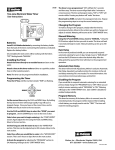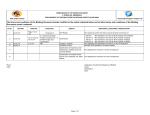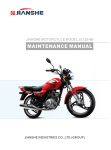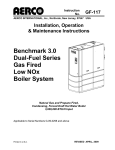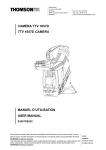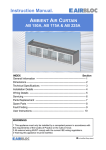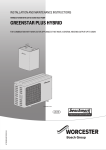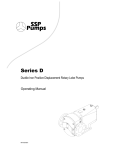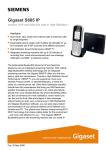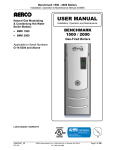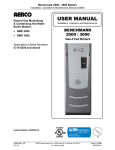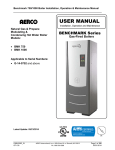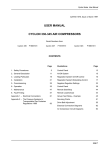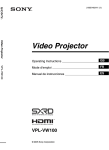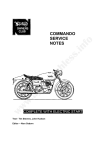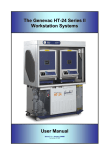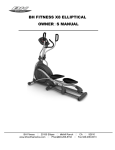Download Installation, Commissioning & Service Manual
Transcript
DIRECT GAS FIRED CHV UNIT DIRECT GAS FIRED CHV UNIT RM 220 80:20 WITH SMARTCOM Installation, Commissioning & Service Manual Index Section 1. Technical Specification 2. General Description 3. Shipping List 4. General Installation - including Roof Opening Diagrams 5. Connection of Services 6. Commissioning and Testing 7. Commissioning Setting 8. Schematic Diagrams 9. Operating Instructions 10. Fault Finding 11. Servicing 12. Recommended Spare Parts 13. Replacement Instruction Appendix 1 Leak testing the gas line. Appendix 2 NGII Burner Assembly. Appendix 3 Wiring Diagram Appendix 4 Commissioning Sheets Appendix 5 SmartCom Manual 1.0 Technical Specification Heater model number Country Outside design temperature Max supply temperature External resistance Air volume Maximum heat input Minimum heat input Maximum heat output Minimum heat output Gas type Category Flue type Gas rate Burner pressure high fire Start gas burner pressure Profile plate diff pressure Maxumum fuel gas supply pressure Minimum fuel gas supply pressure Fuel gas connection size Gas port size Heater arrangement Profile plate opening full fresh air Profile plate opening min fresh air Profile plate opening recirculation air Burner module Fan motor rating Fan pulley Motor pulley Belt size Electrical supply Power consumption MCB rating 415 volt MCB rating 240 Volt Fuse rating 24 Volt Weight RM 220 GB + IE -2 ºC 40 ºC 30 Pa 4.2m3/sec 220 kW 18.0 kW 198 kW 16.2 kW Natural gas (G20) I 2H A2 21.1m3/hr 6.0mbar Differential 5.0mbar 1.0-2.0mbar 100 mbar 20 mbar 1” BSP 1.8mm DIA Vertical indoor 912mm x 450mm 912mm x 195mm 912mm x 257mm 18” 4kW SPZ 200-3 SPZ 90-3 SPZ 1560 415V/3PH/ 50Hz / 4 Wire 4kW 20 AMP MCB 4 AMP MCB 2 AMP MCB 200 Kg 1 2.0 General Description The unit is fitted with hinged removable access panel doors on the side of the heater for inspection internally of the fan, motor, and burner module. 2.1 Introduction The Nordair/Niche RM air heater is a direct fired unit designed for economical and efficient operation to give clean, healthy environmental conditions and constant, even temperature control. The heater air fan, motor and drive belts are fitted inside the heater casing on the downstream side of the burner. 2.4 Control System The space temperature is controlled via a room sensor, situated at low level, with the heater discharge air temperature controlled between two adjustable set points, via a duct sensor mounted in the discharge head. a) The heater is available as a full fresh air model, suitable for make up air applications, or with the patented Nordair/Niche 80/20 recirculation system. b) Both versions feature a burner mounted in an air handling unit. The burner is especially designed so that a proportion of the incoming air is forced into contact with the flame to ensure rapid mixing and uniform heating to the desired temperature. Each heater is supplied complete with automatic safety and temperature control systems. 2.5 Control Sequence Occupancy times are set within the SmartCom control panel mounted at low level. Outside of occupancy times, a frost set point within the SmartCom unit will start the heater automatically if the room temperature falls below the frost set point. c) Full Fresh Heating Air System A double inlet centrifugal forward curved fan, belt driven from a TEFV electric drive motors, draws fresh air from outside of the buiding through a direct gas fired burner situated within a fixed profile opening, which tempers the air up to the required temperatures prior to discharging into the building via a distribution head. During occupancy times, and below room set point; the heater operates in full fresh air mode with the discharge air temperature being controlled at 40ºC (adjustable) via the duct sensor mounted in the discharge head. It achieves this by modulating the gas control valve motor via an 0-10v dc control signal. Patented 80/20 Recirculation Heating System The 80/20 system incorporate the main fresh air feature, with the addition of a moving profile. Dampers allow 80% of the previously heated air discharged into the building to be recirculated through the heater, once the building has achieved room set point, with the remaining 20% being fresh air which is induced through the burner. The moving profile dampers, comprise of two horizontal plates mounted off bearing runners, with a linbage system connected to a single drive motor. In heating mode, the dampers are driven to the full fresh air position, which closes off the recirc air openings, giving a full fresh air opening around the burner. Once room set point is achieved the profile plates are driven to the full recirc position, which close the opening around the burner so that only 20% fresh air is drawn into the heater, with 80% being drawn through the recirc openings. a) When room temperature set point is achieved, the discharge air temperature is reset to 25ºC (adjustable), and the profile plates are driven to the full recirculation position. The heater will continue to operate in this mode to maintain the room set point, unless additional heat gains within the space, increase the room temperature 1ºC (adjustable) above set point, then, at this point the burner will be switched off, leaving the fan operating in the 80% recirc, 20% fresh air position. Additional Increases in space temperature4ºC (adjustable) will drive the 80/20 dampers to the full fresh air position. 2.6 Control Panel The heater control panel incorporates the Satronic flame programmer, necessary contactors, relays and indication lamps, etc all pre-wired to a terminal rail. 2.2 Gas Burner Assembly A remote SmartCom panel is supplied with each heater. The panel should be mounted at low level and wired back to the heater control panel. Each burner is built up from modular components to give the required heat duty. The burner consists of a heavy-duty iron body which forms the fuel gas manifold, fitted with stainless steel mixing plates carefully designed to withstand the stresses of thermal expansion. The mixing plates are perforated to ensure intimate and progressive mixing of the incoming air with the fuel gas at all firing rates. Supplied as loose items for mounting adjacent to the panel is a room sensor, which must be wired to the SmartCom panel. The Nordair/Niche SmartCom controller mounted at low level provides a number of functions which can be adjusted at low level,including time schedules, temperature setpoints, heating/ventilation select, holiday periods, overtime extensions, lockout reset. See Appendix for the SmartCom operating manual. Each burner assembly incorporates an integral pilot burner with spark igniter and flame rod. The flame rod is used for detecting both the pilot and main flame. 2.3 Heater Casing The heater casing comprises of an aluminium sheet metal skin fitted to a aluminium Pentapost frame. The casing incorporates a burner, galvanised profile plate and mild steel flat bar burner supports. 2 2.7 Burner Sequence The purge, ignition, main flame stages of the burner are carried out via Satronic TMG.740 approved flame programmer. control panel. Overheat In the event of an over-heat condition, within the heater casing, the heater is fitted with over temperature protection, which has to be manually reset if activated. Indication is given by an amber illuminated push button, which has to be pressed to reset this condition. The assembly is strapped onto a 1200mm x 1200mm wooden pallet for easy off loading. 2) 1-off SmartCom controller 3) 1-off room sensor. 4) 1-off PV 75 GRP soaker sheet. The RM heater includes the following safety interlocks:- 5) 1-off PV 75 GRP base, square aperture. 1. Low air differential pressure switch. 2. Overheat Controller. 3. Lockout on flame failure/ or air pressure failure. 6) 1-off PV 75 GRP square cowl. 7) 1-off correction bend with loose flange for site assembly. 8) 2-off main purlin trimmers. 9) 4-off purlin end cleats. 2.8 Safety Interlocks 2.9 Site Wiring Site wiring requires the connection of:1. 415 volt 3 phase 50Hz, 4-wire supply, to the main heater control panel. 2. 9 core PLUS earth cable to the SmartCom panel from heater. 10) 2-off masking flanges. 11) 1-off set of fixing nuts/bolts washers and rivets. 4.0 General Installation 3. 2 core twisted pair screened from SmartCom panel to room sensor, if external room sensor is used. 4. 2 core twisted pair screened from SmartCom main heater control panel. 2.10 Fuel Supply System Start Gas Supply Line The start gas line comprises:- 4.1 Related Documents The installation of the Nordair/Niche Direct Gas Fired Air heater must be in accordance with the relevant requirements of the current Gas Safety (Installation and Use) Regulations, Building Regulations, and the IEE Wiring Regulations. It should also be in accordance with any relevant requirements of the local supplier of gas, Local Authority and Fire Authority, and the relevant recommendations of the following docu ments: 1. Inlet gas isolating valve. 4.1.1British Standards 2. Gas governor. BSEN525:1997 - Requirements for non domestic gas fired forced convection air heaters for space heating. BSEN6230 - Specification for installation of gas fired forced convection air heaters for com mercial and industrial space heating of rated input exceeding 60kW (2nd family gases). 3. Class 1 approved solenoid valves. 4. Gas isolating valve. 5. Pipe work, fittings and pressure test points. The main gas train comprises:1. Inlet gas isolating valve. 4.1.2 Institution of Gas Engineers Publications 2. Combined gas governor, safety shut off valves and strainer. 3. Motorised control ball valve. 4. Burner isolating valve. 5. Pipe work, fittings and pressure test points. IGE/UP/1 IGE/UP/2 Soundness testing and purging of industrial and commercial gas installations. Gas installation pipe work, boosters and compressors on industrial and commercial premises. 4.2 Installation of CRM heater 3.0 Shipping List This shipment comprises Only a competent person shall be allowed to install a CRM heater. 1) 1-off fully assembled burner/fan section pre-wired to a 3 The heater is to be installed at a minimum height of 3m and below a maximum height of 20m from floor level to its base, manufacturer to be consulted for heights above this. The heater must be situated to give 500mm access on all sides, with the discharge nozzle blowing into free area. The allowable external resistance to the fresh air duct work is 30pa. Under NO circumstances must the inlet correction bend/duct work be extended or modified. The roof openings must be prepared in accordance with the details in diagrams 1-4, pages 5-8. Please note the opening in the cladding is larger than that in lining. Nordair/Niche recommend packing is placed between cladding and lining to prevent sag around the roof opening. Once the roof opening has been prepared, apply sealant so that the final assembly will be absolutely watertight. The soaker sheets may now be fitted. Nordair/Niche soaker sheets are designed to fit under the roof ridge cap. With a flat ridge cap, please ensure all the profile filler is replaced and properly sealed when the soaker is fitted. With a profile ridge cap, please ensure sealant is applied to the soaker sheet for a watertight fit with the ridge cap. Use all the available roof fixings to secure the soaker sheet. Nordair/Niche recommend two additional fixings in the middle of each side flap. Please note, where ever possible, you should drill the soaker on a rise in the profile to minimise the risk of water ingress. Having fitted the soaker sheet, the roof angle correction bend may be positioned over the bolts so that the unit will hang vertically inside the building. The roof cowl fits over the same bolts and is secured tightly. The roof cowl can be supplied in the colour of the room cladding. It is fitted with a turndown base to prevent water ingress. Some clients may ask for additional water proofing but in our experience this is not necessary. All remain ing installation work can now be completed inside the building. Cut purlin trimmers to size and secure to purlins and correction bend. Each RM is supplied with 2 purlin trimmers and fittings. They are pre-drilled at each end with an adjustable cleat at one end to compensate for minor deviations in purlin centres. Five bolts are provided to attach the roof angle correction bend to each purlin trimmer. The weight of the unit is now transferred onto the purlins. The heater burner section may then be fitted to the roof angle correction bend followed by the fan section bolted to the burn er section. It is recommended that guide wire should be fitted through the eye bolts loacted at each corner of heater to a pre-drilled point approximately 100mm form the end of the purlin trimmers and secured by 3 bulldog grips. 4.3 4 The remote SmartCom controller should be mounted 1.5m from floor level to an adjacent column underneath the heater which is not subject to high ambient temperatures from local machinery or air velocity discharging from the heater. The SmartCom controller incorporates an internal room sensor or alternatively a remote sensor is supplied for installation away from the controller. Sketch No 1 Cowl 4 off steel support brackets (supplied by Nordair) Airflow 915 SQ Base Soaker 75x75x100 purlin cleats Purlin 150x75 channel purlin trimmer 50x25 masking angle Loose flange 5 Sketch No 2 Plan of opening aker d so e l i f Pro s only t shee ding Clad n latio Insu g Linin f Roo e g an l Roof purlins Roof apex ding Clad n latio Insu g Linin 950 Square hole through cladding required for flat soaker sheets 6 Roof profiled soaker sheets required additional 1220x165 cut out to accomadate soaker sheet gulley Sketch No 3 Detail of PV 75 square cowl Detail of PV 75 base Detail of PV 75 flat soaker 7 Sketch No 4 Side view between purlins 5 off M8 bolts 50x50 angle purlin cleat 4 off M10 bolts 4 off guy wires Note Purlin trimmers drilled and cut to suit purlins View between purlins trimmers 50x25 masking angle 150x75 channel purlin trimmer 8 5.0 Connection of Services 5.1 Gas Supply The Nordair/Niche heater is designed for use with natural gas only. The gas type for this heater is marked on the Appliance Data Badge. Check that the available gas supply is as marked and within the pressure range given in the heater specification. 5.1.1Service Pipes The local supplier of gas should be consulted at the installation planning stage in order to establish the availability of an adequate supply of gas. An existing service pipe must not be used without prior consultation with the local supplier of gas. 5.1.2Meters A gas meter is connected to the service pipe by the local suplier of gas or the local contractor. An existing meter should be checked, preferably by the local supplier of gas, to ensure that the meter is adequate to deal with the rate of gas supply required. 5.1.3Installation Pipes Installation pipes should be fitted in accordance with IGE/UP/1. NOTE: If a long pipe run is needed to supply the heater, the line pressure drop should be calculated before installation and the supply pipe work sized accordingly. Gas pressure at the heater inlet under full fire conditions should be at least 17.5mbar. Gas pressure with the main burner switched off must not exceed 100mbar. The complete installation must be tested for soundness as described in IGE/UP/2. 5.1.4Boosted Supplies Where it is necessary to employ a gas pressure booster, the controls must include a low pressure cut-off switch fitted upstream of the booster. This must shut down the booster in the event of reduced pressure and prevent automatic restart on pressure restoration. The cut-off pressure shall be decided by the local supplier of gas. The method of connection to the main electricity supply must facilitate complete electrical isolation of the heater. The method of connection should be provided adjacent to each heater in a readily accessible position. Wire between the SmartCom controller and the heater control panel with a multi core armoured cable or steel conduit, 9 core PLUS earth and a two pair twisted pair screened. Main supply cables are to be sized to suit the electrical rating of the heater as indicated on the Data Badge/Technical Specification Sheet. Control cable size should not be less than 0.75mm2. NOTE: The appliance and the ancillary controls must be correctly earthed. 5.3 Completion of Installation On completion of the installation the installer should leave attached to the heater(s), on a permanent card(s) the following:a) Date of installation b) Name and address of installer. 6.0 Commissioning and Testing Nordair/Niche RM heaters are fully tested before despatch, but still require to be commissioned once installed by a suitably qualified and competent person. There are two blank copies of the commissioning settings, Section 7, both of which are to be filled in. One copy to be retained in the manual, and the other returned to Nordair. The Nordair/Niche Commissioning Service does not cover responsibility for Sections 5.1, 5.2 and 5.3 which remain the responsibility of the installer. 6.1 General Installation The installation should be checked to ensure that the work carried out is in accordance with the design requirements. Particular attention should be given to the adequacy of the air supply. 6.2 Gas Installation The local supplier of gas must be consulted before a gas presure booster is fitted. Guidance is given for low pressure cut-off switches in the IGE/UP/1. The whole of the gas installation, including the metre, should be inspected and tested for soundness and purged in accordance with the recommendations stipulatd in IGE/UP/2. 6.3 Electrical Installation Where additional controls are used they should be CE approved items. 5.2 Electrical Supply Wiring external to the heater must be installed in accordance with the IEE Wiring Regulations and any local regulations which apply. Nordair/Niche RM units are supplied for 415 V ± 6%, 3 phase, 50 Hz, neutral and earth supply, appropriately sized. Checks to ensure electrical safety should be carried out by a competent person. 6.4 Commissioning Procedure To be read in conjunction with the schematic wiring diagram in Appendix 3 and process diagram Section 8. 6.4.1 Each heater is fully tested for safety checks and operational sequence, prior to delivery, but requires the following inspection to be carried out PRIOR TO commencing 9 commissioning. Check that:6.4.2 All manual gas valves are closed. 6.6 Burner Commissioning Commissioning Setting are to be recorded on to the enclosed blank sheets, one copy to be retained in the manual, one copy to be returned to Nordair. 6.4.3 All electrical supplies are isolated. 6.6.1 On low level control panel overide to the on position. 6.4.4 Electrical earth continuity between the heaters, gas pipework and main electrical supply. 6.4.5 Gas installation pipe work has been tested for soundness. 6.4.6 Gas installation has been purged. 6.4.7 Note and record fan motor date badge details. 6.4.8 Note and record fan and motor pulley sizes, belt reference and pulley centres. 6.4.9 Note and record fan belt tension and alignment. 6.4.10Check overheat thermostat is set at 75ºC. 6.5 Pre-firing Commissioning 6.5.1 Ensure all MCBs in control panel are in the ‘off’ position. 6.5.2 Set motor overload to motor plate FLC. 6.5.3 Set discharge head vertical distribution blades to give maximum spread, and the horizontal blades slightly upwards, to prevent downwards air movement. 6.5.4 Switch on electrical supply to heater, check voltage across each Phase for 415 volts, and down to neutral for 240 volts. 6.5.5 On the low level control panel, adjust the room set point to 5ºC below room temperature, select the on/off switch to off. 6.6.2 Increase room set point to 5ºC above room temperature on the low level control panel. The flame programmer will commence a 40 second purge, followed by ignition sequence and lockout. Ensure profile plate has been driven to full open (fresh air position). 6.6.3 Open main gas isolating valve V1, and pilot isolating valves V7 and V11. Ensure burner isolating valve V6 is closed. 6.6.4 Connect a suitable manometer to pressure tapping point P7. 6.6.5 Depress the lockout reset button on the front of the Satronic Flame Programmer. A 40 second air purge will commence, followed by pilot ignition and lockout. Check the pilot gas pressure and reset governor, if necessary to 5.0mbar. Additional lockout resets may be required to adjust pilot governor pressure due to the time allowed prior to lockout occurring. Open burner gas isolating valve V6, reset the lockout condition, a 40 second purge will commence followed by pilot ignition, then main flame ignition at low fire. 6.6.9 Within 3 seconds of main flame ignition the gas valve will commence driving to the full open position. Whilst driving flame colour should be blue, with a maximum flame length of 200-300mm (10” to 12”) extending from the burner plates. If flame lengths in excess of 200 to 300mm (10” to 12”) occur, or orange in colour, close burner isolating valve V6, until correct length/colour is obtained. 6.5.6 Switch on MPCB 1, MCB2 and MCB3 the power on lamp will illuminate. Check the profile plate has been driven to maximum fresh air position. 6.6.10 Connect a manometer to pressure tapping point P1. Measure and record the main gas inlet pressure. 6.5.7 On the low level control panel override to the on position The fan will run, check rotation is correct. If not, isolate main electrical supply and change over two of the phases. Switch on the electrical supply and check rotation is correct. 6.6.11 Connect a manometer to pressure tapping point P3 and measure governor outlet pressure, which should be approximately 2.75mbar. If valve V5 had to be closed in 6.6.7 reduce governor outlet pressure and fully open valve V6. 6.5.8 Measure and record the motor FLC on each phase. Ensure that readings are less than the motor plated FLC. 6.5.9 Check and record air velocity over the profile plate. The reading should be between 14 to 16m/sec. 6.5.10 Connect a suitable manometer to the pressure tapping point P5, upstream of the motorised gas valve. Open burner isolating valve V6, and record gas line suction pressure. Close V6 on completion. 6.5.11 Check within the factory area that no air movement can be felt at low level. Adjust horizontal blades in distribution head if necessary. Check gas soundness on the gas control train as Appendix 1 – leak testing the gas line. 10 To increase or decrease the gas supply pressure to the burner, insert a 4.0mm Allen key into the Module governor block, situated under the first safety shut off valve, and turn clockwise to increase the governor outlet pressure, and anti clockwise to reduce outlet pressure. It is strongly recommended that a pressure gauge is connected to pressure point P3 when adjusting governor outlet pressures. DO NOT adjust governor pressure when setting low fire gas pressure. If increasing the governor outlet gas pressure does not increase the burner pressure at high fire, then the gas control valve requires resetting. 6.6.12Connect a manometer across pressure tapping points P5 and P9 to measure the differential gas pressure. To achieve heater rating the differential pressure should be 3.45mbar, adjust the govenor outlet pressure until pressure is obtained. On completion note record govenor outlet pressure. 6.6.13 As a cross check at high fire, measure the outside air temperature and deduct from the duct discharge temperature, this should be a 42ºC. 6.6.14 On the low level control panel reset the room set point to 20ºC below room temperature. The profile damper will drive to the full recirculation position, the gas valve will drive to the minimum position. 6.6.24 Adjust the room set point on the low level control panel to 2ºC above room temperature. The gas valve will commence driving to the open position, and the profile plate to the full fresh air position. 6.6.25 Repeat 6.6.23 to record the differential air pressure across the profile plate at the full fresh air position. 6.7 Safety checks 6.6.15 The flame at low fire should be a small continuous blue flame, along the full length of the burner, with a temperature rise of 5ºC maximum over the outside air temperature. The low fire valve setting may have to be adjusted to obtain this temperature rise if the main gas governor outlet pressure was increased to obtain high fire setting. 6.6.16 To adjust the low fire settings, slacken the M6 nuts from the motor ‘U’ clamp around the valve spindle, and with a pair of grips on the valve spindle, minutely close the valve in small stages, until the 5ºC temperature rise is obtained. With great care, tighten the ‘U’ clamp on to the valve spindle shaft, ensuring the shaft does not move. Irrespective of low fire temperature rise, ensure that the Satronic TMG 740-3 Controller has at least 2 LED’s lit, less than this may give problems on locking out. 6.6.17 On the low level control panel reset the room set point to 5ºC above room temperature. The profile damper will drive to the full open position, the gas valve will drive to the full open position. 6.7.1 Override the SmartCom control panel to the on position, and increase room set point above room temperature. The heater will start up and the burner will fire after the purge period. 6.7.2 Close burner isolating valve V6, lockout will occur. Open valve and reset lockout condition. 6.7.3 Remove air sensing tube from 3 way solenoid valve, the heater will lockout on air failure. Replace and reset. 6.7.4 Adjust overheat controller set point down until heater shuts off on overheat. Reset temperature to 75ºC and reset by depressing the red button on the overheat controller. 6.7.5 Toggle test the switch on back of the overload relay. The fan will shut down and lockout will occur. Reset overload and reset lockout. 6.7.6 On the low level control panel set the time clock to the desired occupancy times (refer to user and operating manual). 6.7.7 Set room temperature set point, refer to operating manual. 6.6.18 The high fire stop has been factory set to ensure the valve opens fully, and should not require adjusting. 6.6.19 Measure and record the maximum and minimum discharge temperatures. The band widths and dead bands will have been preset in the SmartCom controller prior to despatch. 6.7.8 Select auto/vent/heat to the auto position, this will bring heater under the control of the SmartCom controller. 6.8 Limiting emission concentrates Component Carbon Monoxide Carbon Dioxide Nitric Oxide Nitrogen Dioxide Aldehydes 6.6.20 To ensure the burner ignites smoothly and consistently at low fire, overide the heater to off, then on at the low level control panel. Repeat 4 to 5 times to ensure trouble free ignition. 6.6.21 On the low level control panel, ensure the room set point is 2ºC below room set point, and that the profile plate is at the full air recirculation position. Limiting Concentration (CL) ppm (% V/V) 10 (0.001) 2500 (0.25) 5 (0.0005) 1 (0.0001) 0.4 (0.00004) 6.9 Sequence of Operation 6.9.1 Outside of Time Schedule 6.6.22 Connect both ends of a manometer P8 & P9 to the tapping points on the pressure switch sensing tubes, to measure and record the differential air pressure across the profile plate at minimum fresh air. The reading should be between 1.0 to 1.5mbar. 6.6.23 Adjust the air pressure switch by inserting a screw driving into the slotted adjusting screw. Screwing clockwise, increases the pressure range. Anti-clockwise reduces the pressure range. The ideal setting is to screw clockwise until the flags commence to move, then screw anti-clockwise until it remains steady, which is normally around the 0.5mbar mark. Setting higher than 0.5mbar, with the indicator flag bouncing will give rise to nuisance lockouts. Setting around 0.175mbar or less may not lockout the heater in the event of air failure. a) Above frost set point Heater in shut down position, fan and burner off. b) Below frost set point Fan runs, burner start sequence commences, followed by ignition and main flame establishment. Gas control valve modulates to maintain 40ºC discharge temperature, via duct sensor. Once frost set point is reached heater shuts down as 6.9.1 (a) above. 6.9.2 Inside Time Schedule a) Below room set point i) Fan runs, burner start sequence commences, followed by ignition and main flame establishment. Gas valve modulates to 11 maintain 40ºC discharge temperature via duct sensor. ii) Heater will continue to operate at this condition until the room temperature set point is reached, at which point:- i) The gas valve modulates down to maintain a 25ºC discharge temperature. The profile plates derives to full recirculation air position. ii) The heater will continue to operate at this condition until either: a) The room temperature falls below set point, at which point the gas valve would modulate open to maintain a 40ºC discharge temperature, and the profile plate would drive to the full fresh air position. b) The heater goes outside of time schedule, at which point the heater would shut down as 6.9.1. (a) above. iii) If the room temperature rises 2ºC above the room, the burner will shut down and the fan will continue to run, in the full recirc position setpoint. iv) If room temperature rise 3.5ºC above room set point, the profile plate will drive to full fresh air position, to provide 100% fresh air with the burner remaining in the off state. 12 Report check list SO NUMBER .................................................................. DATE ...................................................... This sheet must be completed by the commissioning engineer after the heater has been started for the first time. TO BE RETAINED IN THE MANUAL CUSTOMER HEATER TYPE SERIAL No BMS CONTROLLER TYPE HEATER ADDRESS CUSTOMER UNIT REFERENCE COMMISSIONING / SERVICE / WARRANTY / BREAKDOWN FAN BALANCE/VIBRATION FAN BEARING/GREASE MOTOR BEARING/GREASE PROFILE PLATE DRIVE/FREE PROFILE DAMPER SLIDE RAILS/GREASE PROFILE DAMPER LIMIT SWITCH/OPERATION PROFILE DAMPER DRIVE LINKAGE PROFILE DAMPER DRIVE MOTOR DRIVE BELT/CONDITION BURNER GAS PORTS/RE-DRILL BURNER MIXER PLATES/REPLACE FLAME PROBE/REPLACE SPARK PROBE/REPLACE INTERNAL CASING CONDITION EXTERNAL CASING CONDITION INTAKE/GRILLES/CLEAN FILTERS IF APPLICABLE DISCHARGE GRILLES SPARK PROBE CAP AND LEAD/CLEAN/REPLACE FLAME PROBE CAP AND LEAD/CLEAN/REPLACE CONTROL PANEL GENERAL CONTROL PANEL WIRING/SOUNDNESS INDICATOR LAMPS FAN ROTATION SUPPLY WIRING GENERAL Engineer ................................................................................. 13 Report check list SO NUMBER .................................................................. DATE ...................................................... This sheet must be completed by the commissioning engineer after the heater has been started for the first time. TO BE RETURNED TO NORDAIR/NICHE CUSTOMER HEATER TYPE SERIAL No BMS CONTROLLER TYPE HEATER ADDRESS CUSTOMER UNIT REFERENCE COMMISSIONING / SERVICE / WARRANTY / BREAKDOWN FAN BALANCE/VIBRATION FAN BEARING/GREASE MOTOR BEARING/GREASE PROFILE PLATE DRIVE/FREE PROFILE DAMPER SLIDE RAILS/GREASE PROFILE DAMPER LIMIT SWITCH/OPERATION PROFILE DAMPER DRIVE LINKAGE PROFILE DAMPER DRIVE MOTOR DRIVE BELT/CONDITION BURNER GAS PORTS/RE-DRILL BURNER MIXER PLATES/REPLACE FLAME PROBE/REPLACE SPARK PROBE/REPLACE INTERNAL CASING CONDITION EXTERNAL CASING CONDITION INTAKE/GRILLES/CLEAN FILTERS IF APPLICABLE DISCHARGE GRILLES SPARK PROBE CAP AND LEAD/CLEAN/REPLACE FLAME PROBE CAP AND LEAD/CLEAN/REPLACE CONTROL PANEL GENERAL CONTROL PANEL WIRING/SOUNDNESS INDICATOR LAMPS FAN ROTATION SUPPLY WIRING GENERAL Engineer ................................................................................. 14 Commissioning setting RM heaters This sheet must be completed by the commissioning engineer after the heater has been started for the first time. TO BE RETAINED IN MANUAL CUSTOMER HEATER TYPE SERIAL No CONTROLLER TYPE BIT SWITCH No MOTOR MOTOR PULLEY FAN PULLEY BELTS BELT CENTRES ALIGNMENT TENSION 100% FRESH AIR OPENING 20% FRESH AIR OPENING 80% RECIRCULATION OPENING VELOCITY 100% F/A VELOCITY 80% REC BURNER SIZE CURRENT F/A L1 L2 L3 CURRENT REC L1 L2 L3 OVERLOAD SIZE GAS LINE SUCTION F/A GAS LINE SUCTION REC LOW FIRE HIGH FIRE DIFF GOVERNOR INLET PRESS GOVERNOR OUTLET PRESS PILOT PRESSURE AIR PRESSURE DIFF F/A AIR PRESSURE DIFF REC AIR PRESSURE SWITCH SET OVERHEAT SET @ CHECKS FULL SYSTEM CHECK LOCKOUT FLAME FAILURE PROFILE PLATE LOCKOUT AIR FAILURE GAS TRAIN SOUNDNESS GAS VALVE POSITION OVERHEAT STAT GAS VALVE MODULATION Engineer....................................................................... Date.................................... 15 Commissionng setting RM heaters This sheet must be completed by the commissioning engineer after the heater has been started for the first time. TO BE RETURNED TO NORDAIR/NICHE CUSTOMER HEATER TYPE SERIAL No CONTROLLER TYPE BIT SWITCH No MOTOR MOTOR PULLEY FAN PULLEY BELTS BELT CENTRES ALIGNMENT TENSION 100% FRESH AIR OPENING 20% FRESH AIR OPENING 80% RECIRCULATION OPENING VELOCITY 100% F/A VELOCITY 80% REC BURNER SIZE CURRENT F/A L1 L2 L3 CURRENT REC L1 L2 L3 OVERLOAD SIZE GAS LINE SUCTION F/A GAS LINE SUCTION REC LOW FIRE HIGH FIRE DIFF GOVERNOR INLET PRESS GOVERNOR OUTLET PRESS PILOT PRESSURE AIR PRESSURE DIFF F/A AIR PRESSURE DIFF REC AIR PRESSURE SWITCH SET OVERHEAT SET @ CHECKS FULL SYSTEM CHECK LOCKOUT FLAME FAILURE PROFILE PLATE LOCKOUT AIR FAILURE GAS TRAIN SOUNDNESS GAS VALVE POSITION OVERHEAT STAT GAS VALVE MODULATION Engineer....................................................................... 16 Date.................................... Section 8 Electrical drawing/process diagram Moduline gas valve assembly Internal strainer Valve and instrument list V1 v3/v4 v5 V6 V7 V8 V9/V10 V11 V12 DM AF FR IT M1 P4 T1 T2 T3 T4 Main gas isolating valve Combination main safety shut off Valves incorporating governor Motorised ball valve Burner isolating valve Pilot gas isolating valve Pilot governor Pilot solenoid valve Pilot isolating valve 3 way solenoid valve Damper motor Air fan Flame rod Ignition transformer Modulating control valve motor Air pressure switch Room sensor Duct sensor Outside air sensor (Optional) Overheat stat Pressure test points 17 Section 8 Electrical drawing/process diagram Fresh air Roof line PV 75 cowl, soaker and upstand Igition transformer Inlet correction bend Fresh air Recirc air Flame probe Spark probe Gas control valve Recirc air Main SSOV Burner Moving profile plates Air pressure switch Profile plate drive motor 3 way solenoid valve Linkage assembly Duct discharge sensor Air fan 2 way distribution head Overheat stat Electrical motor 18 9.0 Operating Instructions 10.0 Fault Finding 9.1 Check that the power on light is illuminated on the heater, and that the LED display is on the SmartCom panel. 10.1 General 9.2 Ensure the time schedules are entered in the SmartCom panel. (Refer to instruction manual at rear for more information). 9.2.1 Enter the required room temperature. (Refer to instruction manual at rear for more information). If the room temperature is 2ºC below set point, the fan and burner will be on, and the discharge air temperature will be approximately 40ºC . As the room temperature is reached the discharge temperature will reduce to 25ºC and the profile plates will drive to the full recirc position. The heater will operate in this mode until the room temperature is 2ºC above set point, at this point the burner will go off and the fan only will operate. 9.2.2 If an ignition attempt fails, the heater will go to lockout and the red light will illuminate on the heater, and lockout indica tion will be shown on the SmartCom controller. Should either the burner fail in operating or its light up sequence fail, the following procedures should be carried out. Check that the connectors to the spark electrode and flame detector are securely fixed and that there has been no interruption to the gas, air or electric supplies. Flame Failure lockout is indicated on the heater via a red indication lamp. Reset can be achieved by a) depressing the satronic flame programmer RESET button, situated with the heater control panel. b) depressing the illuminated push button on remote panel. If the burner still fails to ignite, proceed to carry out systematic checks in accordance with the fault-finding guide. 10.2 Control System Fault Finding 9.2.3 To reset, either press the lockout button on the heater or press the reset button on the SmartCom panel. (Refer to instruction manual at rear for more information). 9.2.4 If lockout occurs again, switch off the heater and call your Service Engineer or Nordair/Niche on 0161 219 0000. 9.2.5 If during normal operation the amber light illuminates, this indicates an overheat condition. To reset this you press the red button on the overheat switch on the heater. If overheat occurs again switch off heater and call your Service Engineer or Nordair/Niche on 0161 219 0000. 9.3 Shut down will be done automatically or manually via the SmartCom panel. (Refer to instruction manual at rear for more information). The satronic burner controller has a coloured timing wheel and pointer visible through the controller itself; this may be used to establish the cause of a fault. When failure occurs the controller stops and remains in this condition until reset. After the controller has been successfully reset, the controller cycles to the beginning of its cycle (start of the blue section) and recommences the purge sequence. The complete cycle i.e. from the start of the blue section to the start of the black section normally takes 1 min 28 seconds for the TMG 740-3, Satronic Flame Programmer NOTE:References to terminal numbers in this section relate to those in the satronic burner controller sub-base and do not correspond to the numbers on the terminal strip in the control panel. Refer also to satronic TMG 740-3 data sheet. Nordair/Niche (A Division of Ambi-Rad Ltd) Unit 22, Battersea Road, Heaton Mersey Industrial Estate, Stockport, Cheshire, SK4 3EA Telephone: 0161 219 0000 Fax: 0161 219 0001 19 Symptom Fault Action 1) Regardless of the position of the coloured wheel, the controller does not move even when reset. i) No power supply to the controller. I) Check electrical supply-live to terminal 20 neutral to terminal 8. ii) Faulty controller. ii) Check by replacement. i) Controller is permanently sensing a flame. ii) Fault on remote reset circuit. i) Check to see if there is a flame caused by leaking gas valve. ii) Check wiring terminal 11. iii) Fault controller. iii) Check by replacement. iv) Flame probe earthing. iv) Check probe condition if necessary. i) Control circuit not complete. i) Check continuity from terminal 9 to terminal 10. ii) Air pressure switch in the normal closed position, i.e. air flow is sensed. ii) Check air pressure proving system and wiring to air pressure switch. Check feed between terminals 16 and 17. i) Air pressure switch is not changing to normally closed position within the first 8 seconds. i) Check fan is running i.e. oveloads/circuit breakers have not tripped. ii) Flame sensing probe earthing. ii) Check air pressure proving system and in particular the operation of wiring to the air pressure switch. Check also air sensing pipes are not blocked. iii) Flame sensing probe earthing. iii) Reposition or replace flame sensing probe. i) Air pressure switch changed back to the normally open position i.e. insufficient air flow. i) Investigate cause of insufficient air flow. ii) Controller senses flame or simulation of flame. ii) Investigate cause of flame signal. 6) Pilot flame established for few seconds but controller locks out at the end of the yellow section. i) Failure to sense pilot flame. i) Check position and wiring to flame sensing probe. Check also the probe if clean and dry. 7) Lockout at the end of the yellow section without any appearance of pilot flame. i) Pilot flame not established due to a lack of gas. i) Check that start gas valve is opening and gas is flowing. Also check that gas isolation valves are open. ii) Pilot flame not established due to no ignition. ii) Check spark gap and that spark is present and is arcing in the correct place. The ignition transformer is energised via terminal 3 at the end of the orange section and start of the yellow section. Check also that HT lead is in good condition. i) Unstable pilot flame flame, small light blue flame. i) Check start gas adjustment for satisfactory 2) Controller permanently locked out and cannot be reset. 3) Controller on black/blue border and will not move. 4) Lockout at red line near start of the blue section. 5) Lockout during the second blue section. 8) Lockout during red section. ii) Check position of and wiring to flame sensing probe. Check also that the probe is clean and dry. iii) Check if gas is turned on. 20 Symptom Fault Action 9) Lockout near the start of the green section. i) Unstable main flame. i) Check the main gas/combustion air adjustment for satisfactory flame. ii) Check position of and wiring to flame sensing probe. Check also that the probe is clean and dry. 10) Lockout at the end of the green section. This is the normal running postion of the control system. 11) Controller cycles through the ignition sequence and stops on the green/black line without any flame, ignition, valves opening. i) Insufficient air flow causing air pressure switch to change to the normally open position. i) Check the air pressure proving system and investigate the cause of insufficient airflow. ii) Flame failure due to loss of gas supply. ii) Investigate the cause of gas failure. iii) Flame failure due to an unstable flame. iii) Check the flame signal during the switching from high to low or low to high fire. Adjust gas rates as necessary and recommission the burner. iv) Flame failure due to week flame sensing signal. iv) Check position of and wiring to the flame sensing probe. Check also that the probe is clean and dry. v) No main flame. v) Check main SSOVs are opening. i) Break in auxiliary contacts between the air pressure switch and the burner controller. i) Check the wiring contimuity from terminal 18 to 16 via the air pressure switch. NOTE In the event that the fault cannot be traced, it is recommended that the services of a Nordair Engineer be obtained. Nordair /Niche(A Division of Ambi-Rad Ltd) Unit 22, Battersea Road, Heaton Mersey Industrial Estate, Stockport, Cheshire, SK4 3EA Telephone: 0161 219 0000 Fax: 0161 219 0001 21 11.0 Servicing The servicing of the RM Heater must only be carried out by a competent person. For two year operation, we recommend that the following items should be held in stock.- It is recommended that the heater is serviced twice a year, a major service carried out prior to the heating season, and a minor service after 2000 running hours. Description Spark probe Flame probe IEG 18-6 Satronic TMG 740-3 Model 43-45 Duct Sensor Relays Belts (3 per set) Ignition transformer After servicing the heater should be re-commissioned as per Section 6.0. 11.1 Routine Servicing Warning: Isolate electricity supply and gas supply before servicing. Access to the burner is through the two access panels on either side of the heater. The fan, motor and drive belts, are accessible through the removable side plate on the fan section, under neath the control panel. Remove and clean spark igniter with a wire brush. Replace it every two years. Inspect and clean with a dry clean cloth the flame rod to ensure freedom from dirt and moisture. Replace the flame rod when showing signs of excessive wear. Part No. N 1014 N 1007 N 1000 SC-D5 Refer to Manufacturer Refer to Manufacturer N 1010 Should the heater be in constant operation, we suggest the following items be stocked at all times. Description Pilot solenoid valve RMV 6 Main S.S.O.V. Coil Modulating Control Motor NM24SR Overheat stat Air pressure switch JD2 Overload 7.5/11 Motor MCB 20 amp Control MCB 4 amp 1/8” BSP 3 way Solenoid valve Part No. Refer To Manufacturer Refer to Manufacturer N 9002 N 7042 N 3038 N 1201 N 1144 N 1154 N 3004 Remove the protection boot from the spark electrode caps, wipe clean with a clean cloth both the HT and flame probe leads, replace the protection boot. We strongly recommend that your heater be serviced twice a year, a major service carried out prior to heating season and a minor service after 2000 running hours. Check fan belts for wear and tension after 2000 hours of operation. Nordair must be consulted if genuine parts are not to be used. Check condition of burner ports, if necessary, clear the ports using a 1.8mm drill. Note: Check stainless steel mixing plates for cracking. Contact Nordair /Niche (A Division of Ambi-Rad Ltd) Unit 22, Battersea Road, Heaton Mersey Industrial Estate, Stockport, Cheshire, SK4 3EA Inspect the entire external system for signs of leakage, wear or general damage. Telephone: 0161 219 0000 Fax: 0161 219 0001 The tension of each belt should be determined using a belt tensioner. Leak test the pipe work and safety shut-off system in accordance with the procedure given in Appendix 1 and check gas soundness. Check control settings. See Section 7 for Commissioning Figures. Outer casing and blades to be wiped with a damp soapy cloth, then dried. 22 12.0 Recommended Spares 13.0 Replacement Instructions 13.8 Gas Train Components Replacement of components should only be carried out by competent persons. Inadvertent substitution or replacement of similar components, particularly those with plug-in bases, could cause a hazard. Access to the heater will require a suitable access platform. 13.1 Heater Isolate the gas and electricity supply, disconnect electrical connections to valves and modulating valve motor unit. Unscrew unions on gas train, replace components where necessary using approved thread sealing compound, re-fit and tighten unions. Gas train should be leak tested as detailed in Appendix 1 and re-commissioned. Isolate the electrical supply to the heater and disconnect at the heater terminals. The main electrical multicors and beldon cable to the remote SmartCom panel. Isolate the gas supply and break the heater union. 13.9 Drive Belts With the heater supported by the access platform, remove the bolts from the heater/correction bend flanges and lower the heater down to floor level. 13.10 Motor 13.2 Access to the Air Fan is via the hinged access doors, and a removal panel on the opposite side. Loosen the motor slide plate adjusting the screw and remous belts. Remove duct sensor, support the discharge head and remove the bolts from the flange. This will also release the fan flange. Remove the four bolts from the fan support feet and remove the air fan. Refit new fan in reverse order, check both fan & motor pulleys are alligned, and tensioned correctly. 13.3 Main Burner Assembly (Remove at Ground Level) Disconnect main gas supply union and pilot gas supply, HT cable and flame rod connections. Unbolt burner straps from burner supports and remove assembly from the heater. If necessary, replace damaged sections as required, re-join flanges using Hermetite, Plasticoll X10G joining compound. Replace burner assembly in reverse order to removal. Check operation and combustion as detailed in the Commissioning Instructions Section 7. 13.4 Ignition Electrode Isolate electrical supply, remove HT cable, unscrew ignition electrode from burner body, replace with new and reconnect HT cable, and protective boot. 13.5 Ignition Transformer Isolate electricity supply, unbolt ignition transformer. Disconnect cable from terminal block and remove and replace the ignition transformer. Re-connect cables. 13.6 Flame Electrode Isolate electrical supply, remove cable and protective boot from flame rod, unscrew old rod and replace with a new one, bending the probe through 45 degrees so that the probe runs parallel to the burner plates. It will be necessary to straighten the old probe prior to unscrewing from the burner and plate. 13.7 Modulating Gas Valve Control Unit Isolate electric supply, unbolt the motor clamp from valve spindle and remove the motor from motor mounting bracket, replace and re-connect. Care should be taken not to move the valve spindle as this will alter the low fire setting. Re-commission heater setting on completion. Access is via the hinged access doors in the fan section. Loosen motor adjusting screw, replace belts, and re-tension. Disconnect cable to motor. Loosen motor slide plate, adjusting screw and remove belts. Remove motor pulley and bush. Unbolt motor fan from slide plate, re-fit new motor, existing pulley and bush in reverse order. Check both motor pulley and fan pulley are parallel and in alignment. Re-fit belts and retension. 13.11 Duct Sensor Isolate electrical supply, remove cover, disconnect the Beldon cable, remove retaining screws, and fit new sensor. Replace in reverse order. 13.12 Air Differential Pressure Switch Isolate main electrical supply, remove cover of pressure switch, terminal box. Disconnect electrical supply, remove sensing tubes and unbolt pressure switch from mounting bracket, replace the switch, re-connect the tube, re-connect the electricity supply. Re-commission the differential pressure switch by setting to 0.5 mbar and checking operation. Note, it will send the heater to lockout if adjusted any higher than the air pressure differential. 13.13 Control Panel Components Burner Programmer. Unscrew body from terminal base and replace. 13.14 Relays Unplug body and replace. 13.15 Motor MPCB Disconnect motor cables from both sides of the motor protec tion circuit breaker and replace. 13.16 Control MCB Remove and replace. 13.17 Overheat Thermostat Isolate electrical supply, remove cables from stat, remove from fan casing, re fit new stat, connect cables and reset to 75ºC. 23 Appendix 1 Leak Testing the Gas Line This procedure should be used in conjunction with the Process and Instrumentation drawing included in the General Piping and Wiring Diagram, Section 5. 1. Ensure that gas and electricity supplies are turned off and close manual valves V1, V6, V7 and V11. TESTING THE PIPEWORK UP TO AND INCLUDING THE UPSTREAM MAIN SAFETY SHUT-OFF VALVES 2. Connect a suitable pressure gauge to pressure test points P2. 3. Open V1 to pressurise the governor assembly. 4. Close V1. Leave the system for 3 minutes and watch for a fall in pipework pressure. If the pressure falls, open V1 and test for leaks with a soap solution. Make good as necessary and recheck. Note : Three minutes should be allowed for all pressure tests. 5. If no external leaks are observed, the upstream main safety shut-off valve is passing. To check this, replace the sealing screw on the pressure test point 2 and connect the pressure gauge to test point 3 and leave for 3 minutes with V1 still open. A rise in pressure confirms the upstream main valve is passing. Replace valve and recheck for soundness. Testing the Downstream Main Safety Shut-off Valve 6. Close V1 and connect pressure test points P1 and P4 with a length of rubber tubing. 7. Open V1 to pressurise the assembly up to the burner isolating valve, V6. 8. Using a leak detection solution check all joints downstream of the second safety shut off valve up to V6. If leaks are detected close V1 and remake leaking joints. Repeat 7 and 8 to recheck after assembly. 9. If no external leaks are observed, close V1 and connect rubber tube to pressure test point P1 and P3 to pressurise the assembly between the two safety shut off valves. Connect pressure gauge to pressure test point P4. 10. Open V1, any rise in pressure indicates the downstream safety shut off valve is passing. Replace valve and recheck for soundness. Testing the Start Gas Pipe work 11. Connect pressure gauge to P2 and open V7 and V1 to pressurise the start gas line to the first gas safety shut-off valve. 12. Close V1. Leave the systems for 3 minutes and watch the pressure gauge. If the pressure falls, open V1 and soap test the start gas pipe work and re-test. 13. If no external leaks are evident the start gas safety shut-off valve is passing. To check this, replace the sealing screw on the pressure test point P2 and connect the pressure gauge to test point P6 and leave for three minutes with V1 still open. A rise in pressure confirms the upstream pilot valve is passing. Replace valve and recheck for soundness. Testing the downstream pilot safety shut off valve 14. Close V1 and V11, connect pressure test points P1 and P7. 15. Open V1 to pressurise the assembly up to the isolating valve, V11. 16. Using a leak detection solution, check all joints downstream of the second safety shut off valve up to V11. If leaks are detected close V11 and remake leaking joints. Repeat 15 and 16 to recheck after assembly. 17. If no external leaks are observed, close V1 and connect rubber tube to pressure test points P1 and P6 to pressurise the assembly between the two safety shut of valves. Connect pressure gauge to pressure test point P7. 18. Open V1, any rise in pressure indicates the downstream safety shut off valve is passing. Replace valve and recheck for soundness. 24 Appendix 2 NGII BURNER ASSEMBLY No. Description 1 Back up bar 2 Body gasket 3 Burner body 4 M10 X 50 LG HEX head set screw 5 3/16” WHIT X 1/2” long hex head set screw 6 M10 nut and washer 7 Support bracket / gasket 8 3/16” with X 1?” long hex head set screw 9 316” with nut and washer 10 Stainless steel mixing plate 11 3/16” with X 3/4” long rd. hd. machine screw 12 End plate Part No. N0008 N0011 N0002 M5X N0010 M5X M5 N0006 M5 x 20 N0004 NG11 Burner assembly 25 Appendix 3 Wiring Diagram 26 Appendix 4 Commissioning Sheets 27 Due to continuous product innovation, Nordair/Niche reserves the right to change product specification without due notice. Nordair/Niche (Northern Office) Unit 22 Battersea Road Heaton Mersey Industrial Estate Stockport Cheshire SK4 3EA United Kingdom Telephone 0161 219 0000 Facsimile 0161 219 0001 UK sales e-mail:[email protected] Website: www.nordair.co.uk Nordair/Niche (Southern Office) Unit 28 Rifle Hill Works Braintree Essex CM7 1EN United Kingdom Telephone 01376 332200 Facsimile 01376 332201 UK sales e-mail:[email protected] Website: www.niche.co.uk is a registered trademark of Ambi-Rad Limited. Document reference number : GB/NOR/060/0106






























